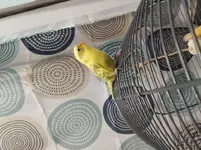Any ideas on what mutation of Parakeet I have? (edited)
I got him/her (I refer to it as her) from the pet store about 2 weeks ago. If you can't see it from the attachment, she is yellow with a green underside and white patches by her eyes. She also has brownish black tips on her wing feathers. Thanks in advance
I got him/her (I refer to it as her) from the pet store about 2 weeks ago. If you can't see it from the attachment, she is yellow with a green underside and white patches by her eyes. She also has brownish black tips on her wing feathers. Thanks in advance
Attachments
Last edited:


